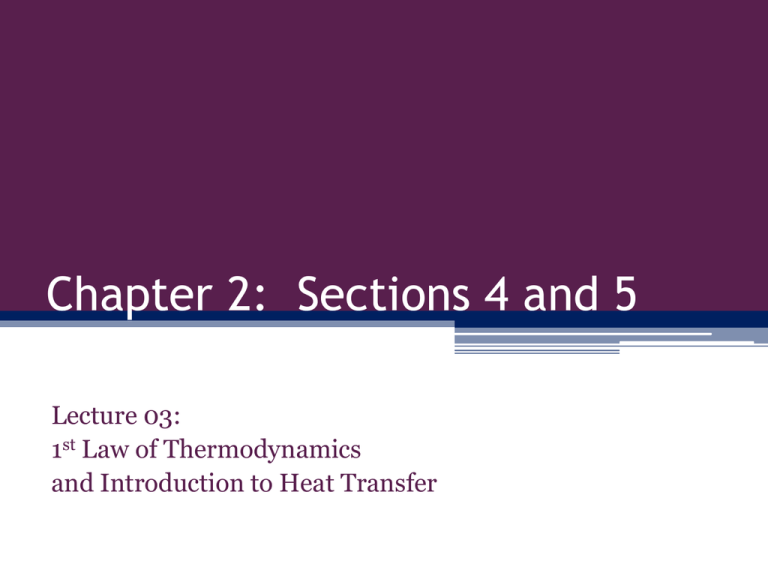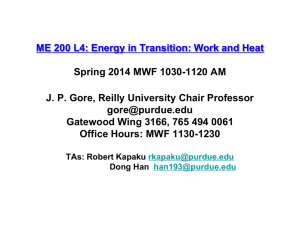Lecture 03: Heat and the 1 st Law of Thermodynamics
advertisement

Chapter 2: Sections 4 and 5 Lecture 03: 1st Law of Thermodynamics and Introduction to Heat Transfer Today’s Objectives: • Be able to recite the 1st Law of Thermodynamics • Be able indicate the sign conventions of the Work and Heat • Be able to distinguish between conduction, convection, and radiation. • Be able to calculate heat flow rate by conduction • Be able to calculate heat flow rate by convection • Bea able to calculate heat flow rate by radiation • Be able to solve Work-Energy system problems using the 1st Law. Reading Assignment: • Read Chap 2. Sections 6 and 7 Homework Assignment: From Chap 2: Problems 49, 53,61, 68 Sec 2.4: Energy Transfer by Heat Heat, Q: An interaction which causes a change in energy due to differences in Temperature. Heat Flow Rate, Q: the rate at which heat flows into or out of a system, dQ/dt. Heat flux, q: the heat flow rate per unit surface area. Q Q dt 3 Sec 2.4.2: Heat Transfer Modes 4 3 Types of Heat Transfer Conduction Radiation Convection Conduction: Heat transfer through a stationary media due to collision of atomic particles passing momentum from molecule to molecule. Fourier’s Law Q A dT dx where κ is the thermal conductivity of the material. Sec 2.4.2: Heat Transfer Modes 5 Types of Heat Transfer Convection: Heat transfer due to movement of matter (fluids). Molecules carry away kinetic energy with them as a fluid mixes. Newton’s Law of Cooling: Q h c A Tb T f hc = coefficient of convection (An empirical value, that depends on the material, the velocity, etc.) Sec 2.4.2: Heat Transfer Modes 6 Types of Heat Transfer Radiation : Heat transfer which occurs as matter exchanges Electromagnetic radiation with other matter. Stefan-Boltzmann Law: Q A Tb 4 Tb = absolute surface temperature ε = emissivity of the surface σ = Stefan-Boltzmann constant Sec 2.4.2: Heat Transfer Modes 7 Summary of Heat Transfer Methods Conduction: Q A where A is area κ is thermal conductivity dT/dx is temperature gradient dT dx Convection: Q h c A Tb T f Radiation: Q A T 4 b where A is area hc is the convection coefficient Tb -Tf is the difference between the body and the fluid temp. where Tb is absolute surface temperature ε is emissivity of the surface σ is Stefan-Boltzmann constant A is surface area 8 Example (2.45): An oven wall consists of a 0.25” layer of steel (S=8.7 BTU/(hftoR) )and a layer of brick (B=0.42 BTU/(hftoR) ). At steady state, a temperature decrease of 1.2oF occurs through the steel layer. Inside the oven, the surface temperature of the steel is 540oF. If the temperature of the outer wall of the brick must not exceed 105 oF, determine the minimum thickness of brick needed. 9 10 Example Problem (2.50) At steady state, a spherical interplanetary electronics laden probe having a diameter of 0.5 m transfers energy by radiation from its outer surface at a rate of 150 W. If the probe does not receive radiation from the sun or deep space, what is the surface temperature in K? Let ε=0.8. Sec 2.4: Energy Transfer by Heat 11 Recall from yesterday: by convention Work, W: W > 0 : Work done BY the system W < 0 : Work done ON the system (This is reversed from the sign convention for work often used in Physics. It is an artifact from engine calculations.) Heat, Q: Q > 0 : Heat transferred TO the system Q < 0 : Heat transferred FROM the system system +Q +W Sec 2.5: Energy Balance for Closed Systems 12 First Law of Thermodynamics Energy is conserved “The change in the internal energy of a closed system is equal to the sum of the amount of heat energy supplied to the system and the work done on the system” [ E within the system ][ ][ ] = net Q input + net W output E system P E K E U Q in W o u t dE Q W where denotes path dependent derivatives Sec 2.5: Energy Balance for Closed Systems 13 The First Law of Thermodynamics The 1st Law of Thermodynamics is an expanded form of the Law of Conservation of Energy, also known by other name an Energy Balance. E system Q in W o u t ΔE Qin system Wout 14 Example (2.55): A mass of 10 kg undergoes a process during with there is heat transfer from the mass at a rate of 5 kJ per kg, an elevation decrease of 50 m, and an increase in velocity from 15 m/s to 30 m/s. The specific internal energy decreases by 5 kJ/kg and the acceleration of gravity is constant at 9.7 m/s2. Determine the work for the process, in kJ. 15 Example Problem (2.63) A gas is compressed in a piston cylinder assembly form p1 = 2 bar to p2 = 8 bar, V2 = 0.02 m3 in a process during which the relation between pressure and volume is pV1.3 = constant. The mass of the gas is 0.2 kg . If the specific internal energy of the gas increase by 50 kJ/kg during the process, deter the heat transfer in kJ. KE and PE changes are negligible. 16 17 Example (2.70): A gas is contained in a vertical piston-cylinder assembly by a piston weighing 1000 lbf and having a face area of 12 in2. The atmosphere exerts a pressure of 14.7 psi on the top of the piston. An electrical resistor transfers energy to the Patm=14.7 psi gas in the amount of 5 BTU as the elevation of the piston increases by 2 ft. The piston and h = 2 ft cylinder are poor thermal conductors and Apiston = 12 in2 friction can be neglected. Determine the Wpiston = 1000 lbf change in internal energy of the gas, in BTU, assuming it is the only significant internal energy change of any component present. Welec= - 5 BTU 18 End of Lecture 03 • Slides which follow show solutions to example problems 19 Example (2.45): An oven wall consists of a 0.25” layer of steel (S=8.7 BTU/(hftoR) )and a layer of brick (B=0.42 BTU/(hftoR) ). At steady state, a temperature decrease of 1.2oF occurs through the steel layer. Inside the oven, the surface temperature of the steel is 540oF. If the temperature of the outer wall of the brick must not exceed 105 oF, determine the minimum thickness of brick needed. 20 Solution to Example (2.45): Heat flow rate through steel: T m Ti S teel A S teel A dx L S teel dT Q S teel Heat flow rate through steel: Q B rick T0 Tm B rick A L B rick Steady State Heat Flow: Both materials have the same cross sectional area here and the heat flow rate through each is the same. Q Q A A S teel B rick 21 Solution to Example (2.45): Therefore: S teel T m Ti T0 Tm B rick L L S teel B rick and solving for Lbrick L Brick Brick T 0 T m Steel L Steel T m Ti with κBrick = 0.42 BTU/(hftoR) κSteel = 8.7 BTU/(hftoR Ti = 540oF Tm= 538.8oF T0= 105oF and LSteel = 0.25 in … solve for Lbrick 22 Solution to Example (2.45): Therefore: 0 . 42 L Brick 8 .7 538 . 8 105 0 . 25 4 . 36 inches 1 .2 23 Example Problem (2.50) At steady state, a spherical interplanetary electronics laden probe having a diameter of 0.5 m transfers energy by radiation from its outer surface at a rate of 150 W. If the probe does not receive radiation from the sun or deep space, what is the surface temperature in K? Let ε=0.8. Solution: where: Q A Tb 4 A sp h ere ε σ d dQ/dt 1 6 d 3 Qout = 0.8 = 5.67 x 10-8 W/m2•K4 = 0.5m = 150 W 1 1 3 3 3 therefore: A sp h ere d (0 .5 m ) 0 .6 5 4 5 m 6 6 1/ 4 Q A T Q Tb A 1/ 4 4 b Q Tb A 150W W 8 2 0.8(5.67 10 )(.6545 m ) 2 4 m K 0.25 266. 6 K 24 Example (2.55): A mass of 10 kg undergoes a process during with there is heat transfer from the mass at a rate of 5 kJ per kg, an elevation decrease of 50 m, and an increase in velocity from 15 m/s to 30 m/s. The specific internal energy decreases by 5 kJ/kg and the acceleration of gravity is constant at 9.7 m/s2. Determine the work for the process, in kJ. Solution: Principle: 1st Law of Thermodynamics E system P E K E U Q in W o u t given: m = 10 kg Qin/m = -5 kJ/kg Δh=-50 m v1 = 15 m/s v2 = 30 m/s ΔU /m= - 5kJ/kg g = 9.7 m/s2 also PE mg h (1 0 kg )(9 .7 m / s )( 5 0 m ) 2 4850 N m 1 KE J kJ N m 1000 J 2 1N kg m / s 2 4 .8 5 kJ 1 m v2 2 1 2 m v1 2 (1 0 kg )(3 0 1 5 ) m / s 2 2 2 2 3375 N m J kJ N m 1000 J 2 N kg m / s 2 3 .3 7 5 kJ 25 Example (2.55): A mass of 10 kg undergoes a process during with there is heat transfer from the mass at a rate of 5 kJ per kg, an elevation decrease of 50 m, and an increase in velocity from 15 m/s to 30 m/s. The specific internal energy decreases by 5 kJ/kg and the acceleration of gravity is constant at 9.7 m/s2. Determine the work for the process, in kJ. Solution continued: U ( U / m )( m ) ( 5 kJ / kg )(1 0 kg ) 5 0 kJ Q in ( Q in / m )( m ) ( 5 kJ / kg )(1 0 kg ) 5 0 kJ Solving for the Work done by the system: W o u t Q in P E K E U ( 5 0 kJ ) ( 4 .8 5 kJ ) (3 .3 7 5 kJ ) ( 5 0 kJ ) 1 .4 7 5 kJ 26 Example Problem (2.63) A gas is compressed in a piston cylinder assembly form p1 = 2 bar to p2 = 8 bar, V2 = 0.02 m3 in a process during which the relation between pressure and volume is pV1.3 = constant. The mass of the gas is 0.2 kg . If the specific internal energy of the gas increase by 50 kJ/kg during the process, deter the heat transfer in kJ. KE and PE changes are negligible. Solution: starting with the 1st Law of Thermodynamics P E K E U Q in W o u t where: ΔKE=0 ΔPE = 0 p1 = 2 bar also: p2 = 8 bar ΔU/m = 50 kJ/kg V1 = ? m = 0.2 kg V2 = 0.02 m3 pV1.3 = constant therefore: 1 .3 p1V1 p 2V 2 1 .3 p V1 2 p1 1 / 1 .3 8 bar V2 2 bar 1 / 1 .3 0 .0 2 m 0 .0 5 8 1 m 3 3 27 Example Problem (2.63) A gas is compressed in a piston cylinder assembly form p1 = 2 bar to p2 = 8 bar, V2 = 0.02 m3 in a process during which the relation between pressure and volume is pV1.3 = constant. The mass of the gas is 0.2 kg . If the specific internal energy of the gas increase by 50 kJ/kg during the process, deter the heat transfer in kJ. KE and PE changes are negligible. Solution continued: also:p V p 2V 2 1 .3 1 .3 (8 b a r )(0 .0 2 m ) 3 p 0 .0 4 9 5 / V 1 .3 1 .3 0 .0 4 9 5 b a r m (0 .0 4 9 5 b a r m 3 .9 )V 3 .9 1 .3 therefore: 1 .3 p1V1 p 2V 2 1 .3 p V1 2 p1 1 / 1 .3 8 bar V2 2 bar 1 / 1 .3 0 .0 2 m 0 .0 5 8 1 m 3 3 28 so work done is: V2 W V1 V2 PdV ((0 .0 4 9 5 b a r m 3 .9 0.0495 bar m 3.9 )V 1 .3 )dV 0 .0 4 9 5 b a r m 0 .3 V1 0 .3 V1 3.9 3.224 m 0.9 1.177 m 0.9 0.3 V (0.02 m 3 ) 0.3 (0.581 m 3 ) 0.3 0.3 0.0495 bar m V2 3 .9 0.0495 bar m 3.9 3.224 m 0.9 1.177 m 0.9 0.3 0.338 bar m 3 100 kN / m 1 bar 2 1kJ 1kN m 33.8 kJ 29 Internal Energy is given as U ( U / m )( m ) (5 0 kJ / kg )(0 .2 kg ) 1 0 kJ Finally back at the 1st Law: PE K E U Q in W out gives Q in P E K E U W o u t 0 0 (1 0 kJ ) ( 3 3 .7 8 kJ ) 2 3 .7 8 kJ 30 Example (2.70): A gas is contained in a vertical piston-cylinder assembly by a piston weighing 1000 lbf and having a face area of 12 in2. The atmosphere exerts a pressure of 14.7 psi on the top of the piston. An electrical resistor transfers energy to the gas in the amount of 5 BTU as the elevation Patm=14.7 psi of the piston increases by 2 ft. The piston and cylinder are poor thermal conductors and friction h = 2 ft can be neglected. Determine the change in internal Apiston = 12 in2 energy of the gas, in BTU, assuming it is the only Wpiston = 1000 lbf significant internal energy change of any component present. Solution: Apply the 1st law of thermodynamics PE K E U Q in W out U Q in W o u t P E K E Welec= - 5 BTU 31 where mg = 1000 lbf A = 12 in2 Δh = 2 ft Welec_in = 5 BTU Because of the statement “poor thermal conductors”, it can be assumed that this is an adiabatic process (Q = 0) and we will also assume that the process occurs as a slow quasi-equilibrium process in which case the kinetic energy terms will also be small (ΔKE = 0). Finally, since the piston floats on the contained gas, the outside atmospheric pressure maintains a constant pressure on the cylinder…so this is a constant pressure process (isobaric) therefore: KE 0 Q in 0 P E m g h (1 0 0 0 lb f )( 2 ft ) 2 0 0 0 ft lb f W elect 5 B T U (neg. since its put into the system) V2 W PV V1 p d V p (V 2 V1 ) (for constant pressure) 32 Ftop=patm A for equilibrium: W=1000lbf F 0 Fb o tto m Fto p W 0 p A p a tm A W 0 p p a tm W Fbottom=p A 1 4 .7 lb f / in 2 A 1 0 0 0 lb f 1 2 in 2 9 8 .0 3 p si and the increase in Volume: V 2 V1 A h V 2 V1 1 2 in ( 2 ft ) 2 1 2 in 2 8 8 in 3 1 ft therefore the work done by the gas was positive work by the system V2 W PV V1 p d V p (V 2 V1 ) (9 8 .2 lb f / in )( 2 8 8 in ) 2 3 1 ft 1 2 in 2 3 5 7 lb f ft 33 Returning to the 1st law: U Q in W out PE K E U 0 (W P V W elec ) P E 0 U ( 2 3 5 7 ft lb f 5 B T U 7 7 8 ft lb f 1B T U ) ( 2 0 0 0 ft lb f ) U 4 6 7 ft lb f U 4 6 7 ft lb f 1B T U 7 7 8 ft lb f 0 .6 0 B T U










